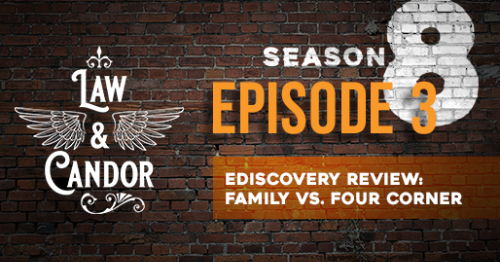Is 2023 the Tipping Point for AI Adoption in Legal?
Generative AI. Bard. Bing AI. Large language models. Artificial intelligence continues to dominate headlines and workplace chats across every industry since OpenAI’s public release of ChatGPT in November of 2022. Nowhere was this more evident than at this year’s Legalweek event. The annual conference, which gathers thousands of attorneys, legal practitioners, and eDiscovery providers together in New York City, was dominated by discussions of ChatGPT and AI. This makes sense, of course. Attorneys must understand how major technology shifts will impact their clients or companies—especially those in eDiscovery and information governance who deal with corporate data and its challenges. But there was a slight twist to the discussions about ChatGPT. In addition to the possible impacts and risks to clients who use the technology, there was just as much, if not more, focus on how it could be used to streamline eDiscovery.The idea of using a tool released to the public less than four months ago seems almost ironic in an industry with a reputation for slowly adopting technology. Indeed, a 2022 ABA survey showed that as few as 19.2% of lawyers use predictive coding technology (i.e., technology assisted review or TAR) for document review, up from just 12% in 2018. Even surveys dominated by eDiscovery software providers showed TAR was being used on less than 30% of matters in 2022. Given that the technology behind traditional TAR tools has existed since the 1970s and the use of TAR has been widely accepted (and even encouraged) by court systems around the world for over a decade, these statistics are strikingly low.So, what is driving this recent enthusiasm in the industry around AI? The accessibility and generative results of ChatGPT is certainly a factor. After all, even a child can quickly learn how to use ChatGPT to generate new content from a simple query. But the recent excitement in eDiscovery also seems to be driven by the significant challenges attorneys are encountering:Macroeconomic volatility and unpredictability have been a near constant stressor for both corporate legal departments and law firms. Legal budgets are shrinking, and layoffs have plagued almost every industry, leaving legal teams to do the same volume of work with fewer resources.Corporate legal teams are being pressured to evolve from a cost center to one that generates revenue and savings, while attorneys at law firms are expected to add value and expertise to all sectors of a company’s business, beyond the litigation and legal sectors they’ve traditionally operated in. And all attorneys are facing increasing demand to become experts in the risks and challenges of the ever-evolving list of new technology used by their clients and companies.New technology is generating unprecedented volumes of corporate data in new formats, while eDiscovery teams are still grappling with better ways to collect, review, and produce older data formats (modern attachments, collaboration data, text messages, etc.) In short, even the most technology-shy attorneys may be finding themselves at a technology “tipping point,” realizing that it is impossible to overcome some of these challenges without leveraging AI and other forms of advanced technology. But while the challenges may seem grim, there is an inherent hopefulness in this moment. The legal industry’s tendency to adopt AI technology more slowly than other sectors means there’s ample opportunity for growth. Some forward-thinking legal teams, with the help of eDiscovery providers, have already been leveraging advanced AI technology to substantially increase the efficiency and accuracy of eDiscovery workflows. This includes tools that utilize the technology behind ChatGPT, including large language models and natural language processing (NLP). And unlike ChatGPT, where privacy concerns have already been flagged regarding its use, existing AI solutions for eDiscovery were developed specifically to meet the stricter requirements of the legal industry—with some already overcoming tough scrutiny from regulators, opposing counsel, and courts. In other words, the big eDiscovery question of 2023 may not be, “Can ChatGPT revolutionize eDiscovery in the future?” but rather, “What can advanced AI and analytic tools do for eDiscovery practitioners right now?” While the former is up for debate, there are definitive answers to the latter threaded throughout many of the other major industry discussions happening now. Some of those discussions include:If you want to go far, go together Today’s larger and more complicated data volumes often make the traditional eDiscovery model feel like the proverbial round hole that the square (data) peg was not designed to fit into. And it’s becoming increasingly expensive for legal teams to try to do so. To operate in this new era, it’s essential to work with partners who can help you meet your data needs and align with your goals. A good example is when an in-house legal team partners with a technology-forward law firm and eDiscovery provider to build a more streamlined and modern eDiscovery program. This kind of partnership provides the resources, expertise, and technology needed to take a more holistic approach to eDiscovery—breaking away from the traditional model of starting each new matter from scratch. These teams can work together to create and deploy tools and expertise that reduce costs and improve review outcomes across all matters. For example, customized AI classifiers built with data and work product from the company’s past matters, cross-matter analytics that identify review and data trends, and tailored review workflows to increase efficiency and accuracy for specific use cases. This partnership approach is a microcosm of how different organizations and teams can work together to overcome common industry challenges. Technology that meets us where we areDespite all the chatter around ChatGPT, there is currently no “easy AI button” to automate the document review process. However, modern eDiscovery technology (including advanced AI) can be integrated into almost every stage of the document review process in different ways, depending on a case team’s goals. This technology-integrated approach to eDiscovery workflows can help case teams achieve unprecedented efficiency and review accuracy, mitigate risks of inadvertently producing sensitive documents, minimize review redundancy across matters, and quickly pull out key themes, timelines, and documents hidden within large data volumes. Technology-forward law firms and managed review partners can help case teams integrate advanced technology and specialized expertise to achieve these goals in a defensible way that works with each company’s existing data and workflows. The only constant is change The days of a static, rarely updated information governance program are gone. The nature of cloud data, the speed of technology evolution and adoption, and the increasingly complex patchwork of data privacy and security regulations mean that legal and compliance teams need to be nimble and ready for the next new data challenge. New generative AI tools like ChatGPT may only add to this complexity. While this type of technology may be largely off limits in the near future for eDiscovery providers and law firms due to client confidentiality, data privacy, and AI transparency issues, companies in other industries have already begun using it. Legal and compliance teams will need to ensure that any new data created by generative AI tools follow applicable data retention guidelines and regulations and begin to think through how this new data will impact eDiscovery workflows.The furor and excitement over the potential use cases for ChatGPT in eDiscovery are a hopeful sign that more legal practitioners are realizing the potential of AI and advanced analytic technology. This change will help push the industry forward, as more in-house teams, outside counsel, and eDiscovery providers partner together to overcome some of the industry’s toughest data challenges with advanced technology.For other stories on practical applications of AI and analytics in eDiscovery, check out more Lighthouse content. lighting-the-way-for-review; ai-and-analytics; lighting-the-path-to-better-reviewai-big-data, blog, ai-and-analytics,ai-big-data; blogsarah moran








